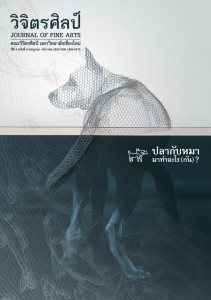17th To Early 19th Century Burmese Murals in Relation to Murals of Siam and Lan Na.
Main Article Content
Abstract
These new technical means and aesthetics then spread outside Pagan at the beginning of the 19th century. The Burmese pictorial tradition remained strongly committed to its fundamentals. In regards to conceptual influence, these Siamese innovations initiated at the Ananda Ok-kyaung were a radical factor in the evolution of Burmese murals. They allowed the rapid development of one of the most dramatic changes since the Pagan period: the shift from the depiction of the Buddha to the depiction of Buddhist society, first witnessed in murals from the first half of the 18th century.
ความสัมพันธ์ระหว่างจิตรกรรมฝาผนังพม่า กับจิตรกรรมฝาผนังสยามและล้านนา ระหว่างคริสต์ศตวรรษที่ 17 ถึงต้นคริสต์ศตวรรษที่ 19
เป็นเวลาไม่ถึง 20 ปีภายหลังการเสียกรุงศรีอยุธยาแก่พม่าในปี ค.ศ. 1767 การปฏิวัติด้านการเขียนภาพได้เกิดขึ้นที่พุกาม ดังหลักฐานในโบราณสถานเดี่ยวๆ หลังหนึ่ง ซึ่งรวบรวมนวัตกรรมใหม่ๆ กว่าสิบลักษณะซึ่งได้เกิดขึ้นเป็นเวลา 150 ถึง 50 ปีมาแล้วในงานจิตรกรรมฝาผนังสยามเข้าไว้ด้วยกัน ภาพจิตรกรรมฝาผนังในโบราณสถานดังกล่าว คือ อานันดาโอวจาวง์ เสร็จสมบูรณ์ในปี ค.ศ. 1786 รวมทั้งจิตรกรรมฝาผนังในอุโบสถอุปาลีเต่ยซึ่งกำหนดอายุอยู่ใน ค.ศ. 1794 และจิตรกรรมฝาผนังของกัมมะจาวง์ อู พยา และเฉว่จาวง์ อู พยา กำหนดอายุใน ค.ศ. 1790 จนสิ้นสุดทศวรรษที่ 1800 สามารถจัดตั้งเป็นกลุ่มจิตรกรรมที่มีลักษณะสอดคล้องกันซึ่งผู้เขียนได้ขนานนามว่า“แบบอานันดา”
ในต้นคริสต์ศตวรรษที่ 19 เทคนิควิธีการและคุณค่าความงามแบบใหม่ในงานจิตรกรรมฝาผนังเหล่านี้ได้แพร่กระจายออกไปนอกพุกาม ขณะที่ธรรมเนียมนิยมในการเขียนภาพแบบพม่าก็ยังคงรักษาไว้ได้อย่างเข้มแข็งในระดับพื้นฐาน หากพิจารณาถึงอิทธิพลเชิงมโนทัศน์ นวัตกรรมแบบสยามเหล่านี้ซึ่งเริ่มต้นขึ้นเป็นครั้งแรกที่อานันดาโอวจาวง์ ได้กลายเป็นตัวแปรในระดับรากฐานต่อการปฏิวัติงานจิตรกรรมฝาผนังพม่า ทั้งยังยอมรับการพัฒนาอย่างรวดเร็วเกี่ยวกับหนึ่งในบรรดาการเปลี่ยนแปลงราวกับละครที่สุดนับตั้งแต่ยุคพุกามเป็นต้นมา นั่นคือการเปลี่ยนจากภาพเล่าเรื่องพระพุทธเจ้า มาสู่ภาพเล่าเรื่องสังคมชาวพุทธ ดังหลักฐานที่พบในงานจิตรกรรมฝาผนังนับตั้งแต่ครึ่งแรกของคริสต์ศตวรรษที่ 18


